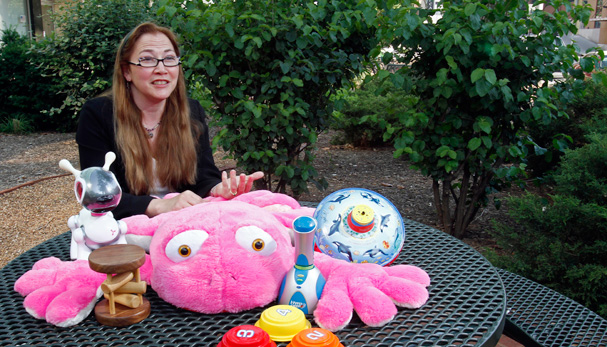By Whitney Heins
UT researcher helps develop standards for green toys
Catherine Wilt has been known to sit down in the middle of a store aisle to read the entire label on a product. She’s especially vigilant about the toys and other items she buys for her 10-year-old daughter, Zoë. When Zoë was a baby, Wilt tried the best she could to keep certain things out of her mouth.
Wilt’s concerns about toys go beyond germs and dirt. She’d like to know how the toy was made, what materials were used, where the materials came from, what effect the materials might have on her child’s health and whether the materials can be recycled when it’s time to throw the toy away. Basically, is this toy healthy for children and the environment?
Wilt has found a way to get answers. As director of the Center for Clean Products at the University of Tennessee, Knoxville’s Institute for a Secure and Sustainable Environment, Wilt (Knoxville ’88, ’89) has helped develop North America’s first and only third-party environmental toy standard. She led an expert advisory committee developing the scientific and social underpinnings of certification standards.
“Whenever there is a health or safety recall of a popular product, there is a moment when your mind starts cycling through all the stuff in your house, thinking, ‘Did we get this brand or that one?'” Wilt says. “As a society, I think we all want to do what is best for our kids, and this standard offers another opportunity to hopefully do just that.”
Called UL 172 in the U.S. (and EcoLogo in Canada), the standard was introduced in February by UL Environment, a subsidiary of Underwriters Laboratories. Companies may voluntarily ask for their products to be certified. It is not a requirement. The certification process is not short, and while some companies have applied, no toys have been certified yet.
UL 172 is applicable to play products made from wood, plastic, rubber, textiles, metal and bio-based materials — from balls to action figures and costume clothing. Due to the high number and diversity of toy components on the market today, certain categories of toys — such as arts and crafts, cosmetics, video games, sporting equipment, furniture, and juvenile products like strollers and car seats — are not covered by the standard at this time.
The UL 172 mark will let parents and any consumer of toys know three things about the products they’re buying:
- They are not harmful to children’s health, meaning they contain no measurable carcinogens, certain neurotoxins, reproductive toxins, anti-microbial agents, heavy metals or added fragrances. The standard also places strict limits on volatile organic compounds, which are a key contributor to childhood asthma.
- The production, use and disposal of toys and their packaging demonstrate green practices such as reducing the amount of packaging used and increasing the use of recycled materials.
- The toys were manufactured in a plant that minimizes pollution, observes workers’ rights and demonstrates other aspects of socially responsible manufacturing.
“The manufacturing and business community has a great deal of power, and they have the potential to be an immense part of our environmental solutions,” Wilt says. “Environmental leadership standards such as this one create an opportunity for companies to make healthier, greener products in facilities that are well-run, responsible workplaces and be rewarded in the best way in the marketplace — by making a profit because consumers value and reward what they are doing.”
Wilt, who has been at UT for 22 years, has worked on a variety of regulations and policies regarding green products and sustainability. She earned her bachelor’s degree in political science and history and master’s degree in environmental planning from UT Knoxville. She believes these standards covering toys are the kind the average person can support because they want children to be safe.
According to the U.S. Consumer Product Safety Commission, there were at least 45 toxic toy recalls between 2008 and 2011. All 45 recalls involved toys that were manufactured outside the U.S. While a North American organization manages UL 172, any toy manufacturer in the world can apply for certification of applicable products.
Wilt hopes parents’ demands for UL 172-certified toys will encourage manufacturers to participate in the program and, as a result, improve the environment.
UL Environment is a nonprofit organization that helps companies achieve their sustainability goals and helps consumers find products they can trust. For more information, visit www.ul.com/environment.
The Center for Clean Products is an internationally recognized leader in the development of environmental product certifications, having developed environmental standards for products and industries as diverse as cleaning products and office electronics to, now, children’s toys. These standards contribute to millions of dollars in green purchases annually and promote products that reduce the negative impacts to human health and the environment. To learn more about the UT Center for Clean Products, visit isse.utk.edu/ccp.



